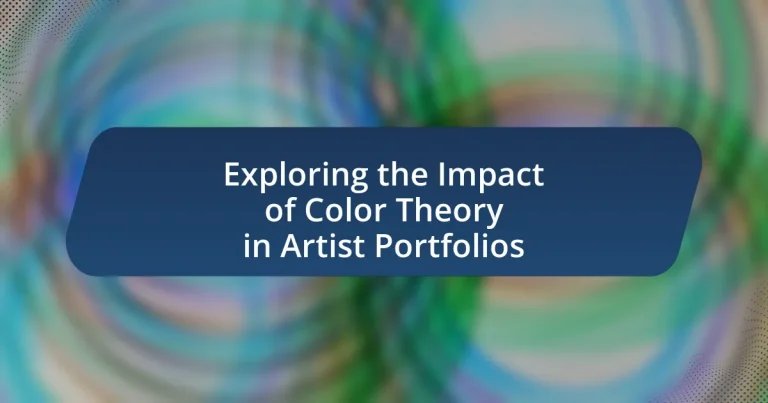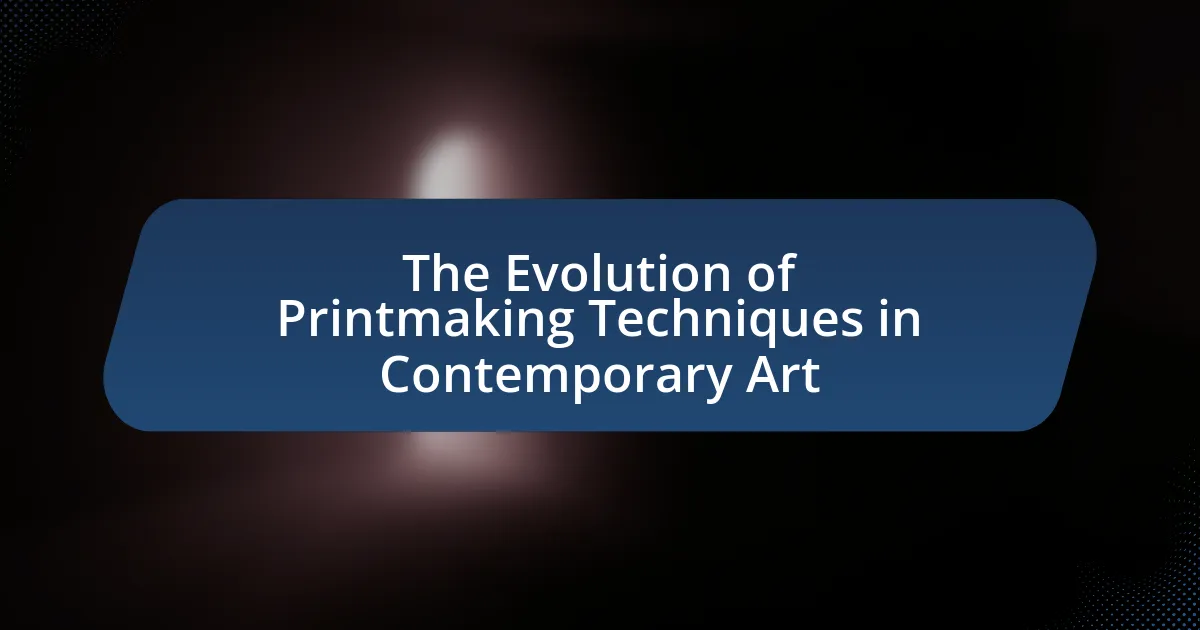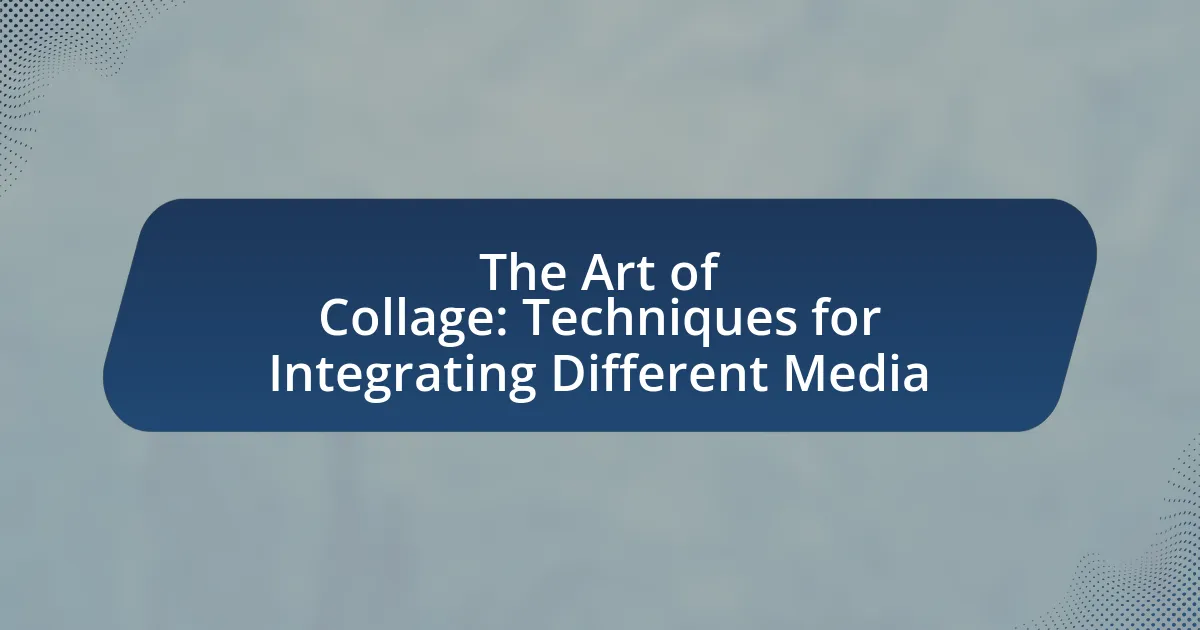The article explores the significance of color theory in artist portfolios, emphasizing its role in enhancing visual communication and emotional impact. It outlines fundamental principles such as the color wheel, color harmony, and the psychological effects of color, which influence artistic expression and viewer perception. The discussion includes strategies for effective color selection, the importance of consistent color use in branding, and the challenges artists face with color theory. Additionally, it addresses how artists can ensure accessibility and inclusivity in their work while continuously improving their color skills through various resources.
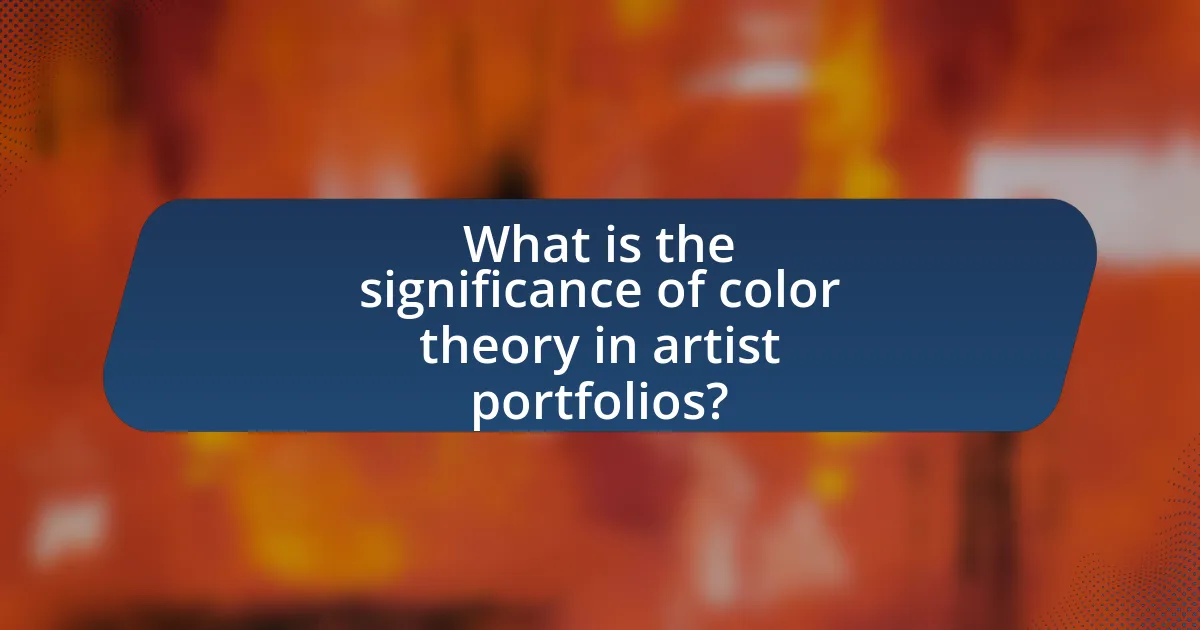
What is the significance of color theory in artist portfolios?
Color theory is significant in artist portfolios as it enhances visual communication and emotional impact. By understanding color relationships, artists can create cohesive works that evoke specific feelings and convey messages effectively. For instance, studies show that colors can influence perception; warm colors often evoke excitement, while cool colors can induce calmness. This knowledge allows artists to strategically select colors that align with their artistic intent, ultimately making their portfolios more compelling and memorable to viewers.
How does color theory influence artistic expression?
Color theory significantly influences artistic expression by providing a framework for understanding how colors interact and evoke emotions. Artists utilize color combinations based on principles such as the color wheel, complementary colors, and color harmony to create visual impact and convey specific moods. For instance, warm colors like red and yellow can evoke feelings of warmth and excitement, while cool colors like blue and green often promote calmness and tranquility. Historical examples include the use of color in Impressionism, where artists like Claude Monet employed color theory to capture light and atmosphere, enhancing emotional depth in their work. This application of color theory not only guides the aesthetic choices of artists but also shapes the viewer’s emotional response, demonstrating its critical role in artistic expression.
What are the fundamental principles of color theory?
The fundamental principles of color theory include the color wheel, color harmony, and the psychological effects of color. The color wheel organizes colors into primary, secondary, and tertiary categories, providing a visual representation of relationships between colors. Color harmony refers to the aesthetically pleasing combinations of colors, which can be achieved through various schemes such as complementary, analogous, and triadic. The psychological effects of color influence emotions and perceptions, with specific colors evoking particular feelings; for example, blue often conveys calmness while red can evoke excitement. These principles are essential for artists to create visually compelling and emotionally resonant works.
How do color harmonies affect viewer perception?
Color harmonies significantly influence viewer perception by creating emotional responses and guiding attention. For instance, complementary color schemes can evoke feelings of vibrancy and energy, while analogous colors often produce a sense of calm and cohesion. Research indicates that color combinations can affect mood and behavior; a study published in the journal “Color Research and Application” by researchers from the University of California found that specific color harmonies can enhance aesthetic appeal and increase viewer engagement. This demonstrates that the strategic use of color harmonies in art can effectively shape how viewers interpret and connect with visual content.
Why is color selection crucial for artists?
Color selection is crucial for artists because it directly influences the emotional response and perception of their work. The choice of colors can evoke specific feelings, create mood, and establish visual harmony, which are essential for effective communication in art. For instance, studies in color psychology indicate that warm colors like red and yellow can evoke feelings of warmth and excitement, while cool colors like blue and green can promote calmness and tranquility. This understanding allows artists to strategically select colors that align with their intended message and audience engagement, thereby enhancing the overall impact of their portfolios.
What psychological effects do colors have on audiences?
Colors significantly influence the psychological responses of audiences, affecting emotions, perceptions, and behaviors. For instance, red often evokes feelings of excitement or urgency, while blue tends to promote calmness and trust. Research indicates that 90% of snap judgments made about products can be based on color alone, highlighting its powerful impact on consumer behavior (Singh, 2006). Additionally, yellow is associated with optimism and energy, whereas green is linked to tranquility and health. These associations can vary culturally, but the underlying psychological effects remain consistent across different contexts, demonstrating the importance of color choice in artistic and marketing endeavors.
How can color choices enhance an artist’s message?
Color choices can significantly enhance an artist’s message by evoking specific emotions and associations that align with the intended narrative. For instance, warm colors like red and orange often convey passion or urgency, while cool colors like blue and green can evoke calmness or sadness. Research indicates that color psychology plays a crucial role in how viewers interpret visual art; for example, a study published in the journal “Color Research and Application” by researchers Andrew Elliot and Markus Maier demonstrates that colors can influence emotional responses and perceptions of meaning in art. Thus, by strategically selecting colors, artists can reinforce their themes and engage their audience more effectively.
What role does color play in branding for artists?
Color plays a crucial role in branding for artists by influencing perception, evoking emotions, and establishing identity. Artists utilize specific color palettes to convey their unique style and message, which helps differentiate them in a competitive market. For instance, research indicates that colors can trigger emotional responses; blue often conveys trust and calmness, while red can evoke excitement and passion. This emotional connection can enhance audience engagement and loyalty, making color a vital tool in an artist’s branding strategy.
How can consistent color use strengthen an artist’s identity?
Consistent color use can strengthen an artist’s identity by creating a recognizable visual language that distinguishes their work from others. This distinctiveness allows audiences to associate specific colors with the artist, fostering brand recognition and emotional connections. For example, artists like Vincent van Gogh are known for their vibrant yellows and blues, which not only define his style but also evoke specific emotional responses in viewers. Research indicates that color consistency can enhance memorability and influence perception, as seen in studies on color psychology, which show that colors can evoke particular feelings and associations. Thus, by employing a consistent color palette, artists can effectively communicate their unique vision and reinforce their identity in the art world.
What are examples of successful color branding in art portfolios?
Successful color branding in art portfolios includes the use of distinct color palettes that reflect the artist’s style and message. For instance, the portfolio of artist Yayoi Kusama prominently features her signature polka dots and vibrant colors, creating a cohesive visual identity that is instantly recognizable. Similarly, the minimalist approach of artist Agnes Martin employs soft, muted colors that evoke tranquility, reinforcing her artistic philosophy. These examples demonstrate how consistent color choices can enhance brand recognition and communicate an artist’s unique vision effectively.

How can artists effectively implement color theory in their portfolios?
Artists can effectively implement color theory in their portfolios by strategically using color harmonies, contrasts, and emotional associations to enhance their visual storytelling. By applying complementary, analogous, or triadic color schemes, artists can create cohesive and visually appealing works that draw attention and convey specific moods. Research indicates that color can influence perception and emotional response; for instance, warm colors often evoke feelings of warmth and energy, while cool colors can create a sense of calmness. This understanding allows artists to select colors that align with the themes of their work, thereby strengthening the overall impact of their portfolios.
What strategies can artists use to choose their color palettes?
Artists can use several strategies to choose their color palettes, including understanding color theory, utilizing color harmony, and drawing inspiration from nature or existing artworks. Understanding color theory allows artists to grasp the relationships between colors, such as complementary, analogous, and triadic schemes, which can enhance the emotional impact of their work. Utilizing color harmony involves selecting colors that work well together to create a cohesive look, which can be achieved through tools like the color wheel. Additionally, drawing inspiration from nature or existing artworks can provide a rich source of color combinations that resonate with the artist’s vision. These strategies are supported by the principles of color psychology, which indicate that specific colors evoke particular emotions, thereby influencing the viewer’s perception and experience of the artwork.
How can artists experiment with color combinations?
Artists can experiment with color combinations by utilizing color theory principles, such as complementary, analogous, and triadic color schemes. By applying these schemes, artists can create visual harmony or contrast, enhancing the emotional impact of their work. For instance, complementary colors, which are opposite each other on the color wheel, can create vibrant contrasts that draw attention, while analogous colors, which are next to each other, can produce a more serene and cohesive look. Research in color psychology indicates that different color combinations can evoke specific emotions, thus influencing viewer perception and engagement.
What tools are available for color selection and analysis?
Tools available for color selection and analysis include Adobe Color, Coolors, and Color Hunt. Adobe Color allows users to create color schemes based on color theory principles, offering features like color wheel manipulation and harmony rules. Coolors is a user-friendly tool that generates color palettes with a simple click, enabling quick exploration of color combinations. Color Hunt provides a curated collection of color palettes, allowing artists to find inspiration and analyze trending color combinations. These tools are widely used in design and art to enhance color selection and ensure effective visual communication.
How can artists showcase their understanding of color theory?
Artists can showcase their understanding of color theory by incorporating a diverse color palette in their works, demonstrating knowledge of color relationships, and applying concepts such as complementary, analogous, and triadic color schemes. For instance, an artist might create a piece that effectively uses complementary colors to create visual tension and interest, which is a fundamental principle of color theory. Additionally, artists can provide color studies or sketches alongside their final pieces to illustrate their thought process and decision-making regarding color choices. This practice not only highlights their technical skills but also reflects their ability to manipulate color for emotional and aesthetic impact, reinforcing the importance of color theory in visual art.
What types of projects best demonstrate color theory knowledge?
Projects that best demonstrate color theory knowledge include color wheel creations, color harmony studies, and design projects that utilize complementary, analogous, or triadic color schemes. These projects allow artists to apply theoretical concepts in practical ways, showcasing their understanding of how colors interact and influence perception. For instance, creating a color wheel requires knowledge of primary, secondary, and tertiary colors, while harmony studies involve selecting colors that work well together based on established color theory principles. Such projects are essential in artist portfolios as they provide tangible evidence of an artist’s ability to manipulate color effectively, which is critical in visual arts.
How can artists articulate their color choices in portfolio descriptions?
Artists can articulate their color choices in portfolio descriptions by clearly explaining the emotional and conceptual significance of their selected colors. This involves detailing how specific hues relate to the themes of their work, such as using warm colors to evoke feelings of warmth and comfort or cool colors to convey tranquility and introspection. For instance, an artist might state that they chose a palette of blues and greens to reflect themes of nature and serenity, thereby providing context that enhances the viewer’s understanding of the artwork. This method not only informs the audience about the artist’s intentions but also demonstrates a thoughtful application of color theory, which posits that colors can influence perception and emotional response.
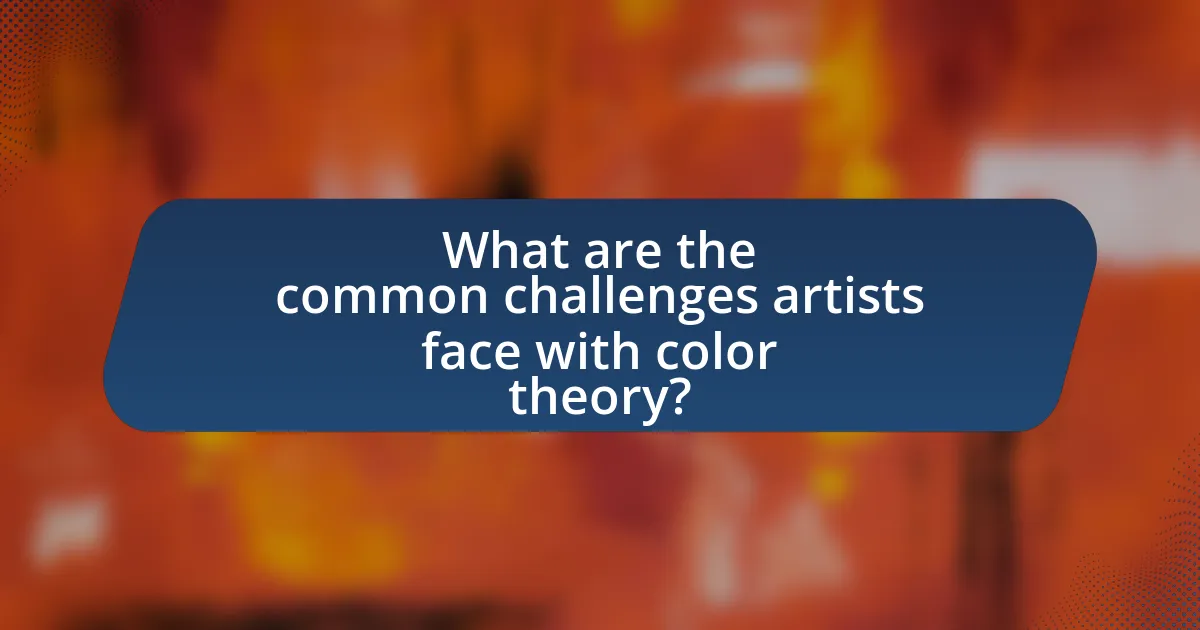
What are the common challenges artists face with color theory?
Artists commonly face challenges with color theory, including understanding color relationships, managing color mixing, and applying color psychology effectively. These difficulties arise because color relationships, such as complementary and analogous colors, can be complex and may lead to unintended visual outcomes. Additionally, artists often struggle with mixing colors accurately, which can result in muddy or unsatisfactory hues. Furthermore, applying color psychology to evoke specific emotions or responses in viewers requires a nuanced understanding of how colors interact and influence perception. These challenges are documented in various art education resources, highlighting the importance of mastering color theory for successful artistic expression.
What misconceptions do artists have about color theory?
Artists often hold misconceptions about color theory, primarily believing that color mixing is straightforward and that primary colors are the only basis for all other colors. This oversimplification neglects the complexities of color relationships, such as the importance of color temperature, saturation, and the effects of light on color perception. For instance, the RYB (red, yellow, blue) model is commonly taught, but the RGB (red, green, blue) model is more relevant for digital art, as it reflects how colors are created on screens. Additionally, many artists underestimate the psychological impact of color, failing to recognize how colors can evoke emotions and influence viewer perception. Understanding these nuances is crucial for artists to effectively utilize color in their work.
How can artists overcome the fear of color experimentation?
Artists can overcome the fear of color experimentation by gradually integrating new colors into their work through small, controlled exercises. This approach allows artists to build confidence and familiarity with different color combinations without the pressure of a large-scale project. For instance, studies in color theory demonstrate that understanding color relationships, such as complementary and analogous colors, can enhance an artist’s ability to make informed choices. Engaging in color mixing exercises or creating color swatches can also provide practical experience, reinforcing the idea that mistakes can lead to unique outcomes and creative breakthroughs.
What are the pitfalls of relying on trends in color usage?
Relying on trends in color usage can lead to a lack of originality and a disconnect from an artist’s unique style. When artists follow popular color trends, they risk producing work that feels generic and fails to resonate with their personal vision. This can diminish their artistic identity and make it difficult for them to stand out in a saturated market. Additionally, trends can be fleeting; what is popular today may be outdated tomorrow, leading to potential obsolescence in an artist’s portfolio. Historical examples, such as the rapid rise and fall of certain color palettes in fashion and design, illustrate how quickly trends can change, emphasizing the importance of timelessness over trendiness in artistic expression.
How can artists address color blindness in their work?
Artists can address color blindness in their work by utilizing color palettes that are distinguishable for individuals with various types of color vision deficiencies. Research indicates that approximately 8% of men and 0.5% of women of Northern European descent experience color blindness, primarily affecting red-green perception. To accommodate these viewers, artists can employ high-contrast combinations, use textures and patterns to convey depth, and incorporate symbols or labels that do not rely solely on color. Additionally, tools like color blindness simulators can help artists visualize how their work appears to those with color vision deficiencies, ensuring their art remains accessible and inclusive.
What adaptations can be made for inclusive color choices?
Inclusive color choices can be adapted by utilizing high-contrast color combinations, ensuring accessibility for individuals with visual impairments. For instance, using colors that are easily distinguishable, such as blue and yellow, can enhance visibility for those with color blindness. Additionally, employing color-blind friendly palettes, like those recommended by the Color Universal Design (CUD) guidelines, can further support inclusivity. Research indicates that approximately 1 in 12 men and 1 in 200 women have some form of color vision deficiency, highlighting the importance of these adaptations in design.
How can artists ensure their work is accessible to all audiences?
Artists can ensure their work is accessible to all audiences by incorporating universal design principles, which include using high-contrast colors, clear typography, and providing alternative text for visual elements. Research indicates that color contrast significantly affects readability; for instance, the Web Content Accessibility Guidelines (WCAG) recommend a contrast ratio of at least 4.5:1 for normal text to enhance visibility for individuals with visual impairments. Additionally, artists can engage with diverse communities to gather feedback on their work, ensuring it resonates with various audiences and meets accessibility standards.
What best practices should artists follow when applying color theory?
Artists should follow the best practices of understanding color relationships, utilizing color harmony, and considering the psychological effects of colors when applying color theory. Understanding color relationships, such as complementary, analogous, and triadic schemes, allows artists to create visually appealing compositions. Utilizing color harmony ensures that colors work well together, enhancing the overall aesthetic of the artwork. Additionally, considering the psychological effects of colors can evoke specific emotions and responses from viewers, which is crucial for effective communication through art. For instance, research indicates that warm colors can evoke feelings of warmth and comfort, while cool colors often convey calmness and serenity.
How can artists continuously improve their color skills?
Artists can continuously improve their color skills by practicing color mixing and studying color theory. Engaging in regular exercises that involve mixing paints to create a wide range of hues enhances an artist’s understanding of color relationships. Additionally, studying color theory, which includes concepts such as the color wheel, complementary colors, and color harmony, provides a foundational knowledge that informs artistic choices. Research indicates that artists who actively apply color theory principles in their work demonstrate improved color usage and composition, as evidenced by studies in art education that highlight the correlation between theoretical knowledge and practical application in artistic development.
What resources are available for learning more about color theory?
Books, online courses, and websites are key resources for learning about color theory. Notable books include “Interaction of Color” by Josef Albers, which provides foundational insights into color relationships, and “Color Theory: A Critical Introduction” by Aaron Frank, which explores color in art and design. Online platforms like Coursera and Skillshare offer structured courses on color theory, often taught by industry professionals. Websites such as Adobe Color and Color Hunt provide practical tools and palettes for color selection, enhancing understanding through application. These resources collectively offer a comprehensive approach to mastering color theory.
